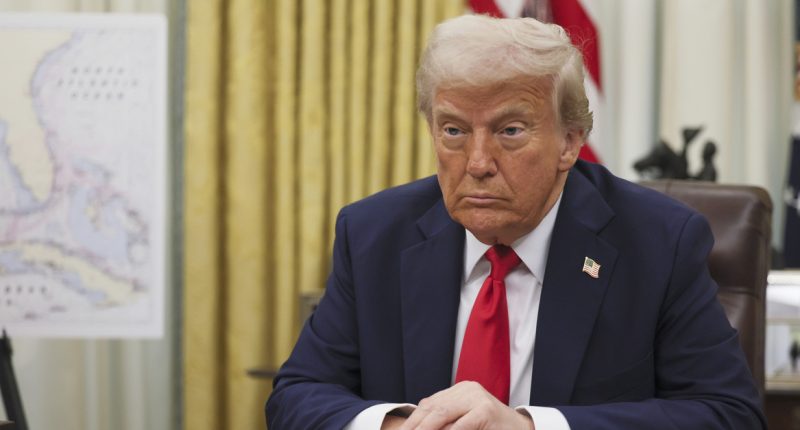
President Donald Trump listens to a question from a reporter before signing an executive order in the Oval Office of the White House in Washington, Monday, March 31, 2025 (Pool via AP).
The Trump administration is asking a federal judge in California to reconsider an order that would force it to disclose its plan for mass firings across multiple agencies as part of the president’s effort to gut the federal workforce, claiming that such “Agency Reductions in Force and Reorganization Plans” (ARRPs) contain privileged information that could, among other things, cause “embarrassment” or “annoyance” for the government.
The underlying litigation challenges President Donald Trump‘s Feb. 11, 2025, executive order: “Implementing The President’s ‘Department Of Government Efficiency’ Workforce Optimization Initiative.” The order purports to commence a “critical transformation of the Federal bureaucracy” by “eliminating waste, bloat, and insularity.” Under the plan, administrative agency heads would be required to “initiate large-scale reductions in force” (RIFs), or massive layoffs, in service of the goal to restructure the government.
U.S. District Judge Susan Illston, a Bill Clinton appointee, granted a request from a coalition of labor unions, nonprofit groups, and municipalities to block the planned firings via a temporary retraining order. The judge also issued a “Disclosure Order” directing that ARRPs submitted to the Office of Management and Budget (OMB) and the Office of Personnel Management (OPM) be provided to the court by Tuesday.
The administration on Sunday sought to have Illston put a hold on the disclosure order prior to the impending deadline.
“The Court should either grant Defendants a protective order from the obligation to disclose the ARRPs or reconsider the Disclosure Order because the ARRPs are privileged pre-decisional and deliberative agency planning documents,” the 14-page filing states. “They also contain significant, highly sensitive information the disclosure of which will irreparably harm OPM, OMB, and the Defendant Agencies, harm that cannot be undone once the documents are disclosed. Defendants submit that the Court’s grant of this extraordinary relief was both substantively and procedurally erroneous.”
Love true crime? Sign up for our newsletter, The Law&Crime Docket, to get the latest real-life crime stories delivered right to your inbox.
Attorneys for the Department of Justice also asserted that halting disclosure of the ARRPs would not irreparably harm the plaintiffs, claiming that such documents are “simply irrelevant to future proceedings in this Court” and that the current plan was “subject to change at any moment.”
The plaintiffs in the case alleged that the Trump administration’s planned firings implicated various separation of power issues, including the usurpation of Congress’ role in wide-ranging government overhauls.
“It is the prerogative of presidents to pursue new policy priorities and to imprint their stamp on the federal government,” Illston wrote in her Friday order. “But to make large-scale overhauls of federal agencies, any president must enlist the help of his co-equal branch and partner, the Congress.”
The court expressed severe misgivings with how the Trump administration tried to achieve its aims.
One of the key problems, Illston observed, was tasking three agencies and offices — the OPM, the OMB, and the so-called Department of Government Efficiency (DOGE) — with most of the heavy lifting. In the litigation, the plaintiffs single out specific memos by OPM and OMB and the widely-publicized — and often self-trumpeted — actions undertaken by DOGE as “unconstitutional and unlawful orders” as part of what they referred to as Trump’s “radical transformation.”
The court finds that neither OPM nor OMB have any statutory authority to terminate agency employees — aside from their own internal employees — “or to order other agencies to downsize” or to restructure other agencies. And, as far as the Elon Musk-led DOGE is concerned, the judge is withering: “As plaintiffs rightly note, DOGE ‘has no statutory authority at all.””
“In sum, no statute gives OPM, OMB, or DOGE the authority to direct other federal agencies to engage in large-scale terminations, restructuring, or elimination of itself,” Illston wrote. “Such action is far outside the bounds of any authority that Congress vested in OPM or OMB, and, as noted, DOGE has no statutory authority whatsoever.”
Colin Kalmbacher contributed to this report.








